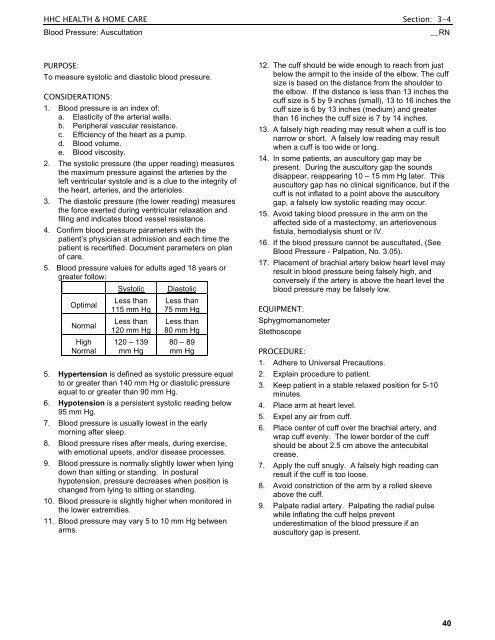HHC Health & Home Care Clinical Policy And
HHC Health & Home Care Clinical Policy And
HHC Health & Home Care Clinical Policy And
You also want an ePaper? Increase the reach of your titles
YUMPU automatically turns print PDFs into web optimized ePapers that Google loves.
<strong>HHC</strong> HEALTH & HOME CARE Section: 3-4<br />
Blood Pressure: Auscultation __RN<br />
PURPOSE:<br />
To measure systolic and diastolic blood pressure.<br />
CONSIDERATIONS:<br />
1. Blood pressure is an index of:<br />
a. Elasticity of the arterial walls.<br />
b. Peripheral vascular resistance.<br />
c. Efficiency of the heart as a pump.<br />
d. Blood volume.<br />
e. Blood viscosity.<br />
2. The systolic pressure (the upper reading) measures<br />
the maximum pressure against the arteries by the<br />
left ventricular systole and is a clue to the integrity of<br />
the heart, arteries, and the arterioles.<br />
3. The diastolic pressure (the lower reading) measures<br />
the force exerted during ventricular relaxation and<br />
filing and indicates blood vessel resistance.<br />
4. Confirm blood pressure parameters with the<br />
patient’s physician at admission and each time the<br />
patient is recertified. Document parameters on plan<br />
of care.<br />
5. Blood pressure values for adults aged 18 years or<br />
greater follow:<br />
Optimal<br />
Normal<br />
High<br />
Normal<br />
Systolic Diastolic<br />
Less than<br />
115 mm Hg<br />
Less than<br />
120 mm Hg<br />
120 – 139<br />
mm Hg<br />
Less than<br />
75 mm Hg<br />
Less than<br />
80 mm Hg<br />
80 – 89<br />
mm Hg<br />
5. Hypertension is defined as systolic pressure equal<br />
to or greater than 140 mm Hg or diastolic pressure<br />
equal to or greater than 90 mm Hg.<br />
6. Hypotension is a persistent systolic reading below<br />
95 mm Hg.<br />
7. Blood pressure is usually lowest in the early<br />
morning after sleep.<br />
8. Blood pressure rises after meals, during exercise,<br />
with emotional upsets, and/or disease processes.<br />
9. Blood pressure is normally slightly lower when lying<br />
down than sitting or standing. In postural<br />
hypotension, pressure decreases when position is<br />
changed from lying to sitting or standing.<br />
10. Blood pressure is slightly higher when monitored in<br />
the lower extremities.<br />
11. Blood pressure may vary 5 to 10 mm Hg between<br />
arms.<br />
12. The cuff should be wide enough to reach from just<br />
below the armpit to the inside of the elbow. The cuff<br />
size is based on the distance from the shoulder to<br />
the elbow. If the distance is less than 13 inches the<br />
cuff size is 5 by 9 inches (small), 13 to 16 inches the<br />
cuff size is 6 by 13 inches (medium) and greater<br />
than 16 inches the cuff size is 7 by 14 inches.<br />
13. A falsely high reading may result when a cuff is too<br />
narrow or short. A falsely low reading may result<br />
when a cuff is too wide or long.<br />
14. In some patients, an auscultory gap may be<br />
present. During the auscultory gap the sounds<br />
disappear, reappearing 10 – 15 mm Hg later. This<br />
auscultory gap has no clinical significance, but if the<br />
cuff is not inflated to a point above the auscultory<br />
gap, a falsely low systolic reading may occur.<br />
15. Avoid taking blood pressure in the arm on the<br />
affected side of a mastectomy, an arteriovenous<br />
fistula, hemodialysis shunt or IV.<br />
16. If the blood pressure cannot be auscultated, (See<br />
Blood Pressure - Palpation, No. 3.05).<br />
17. Placement of brachial artery below heart level may<br />
result in blood pressure being falsely high, and<br />
conversely if the artery is above the heart level the<br />
blood pressure may be falsely low.<br />
EQUIPMENT:<br />
Sphygmomanometer<br />
Stethoscope<br />
PROCEDURE:<br />
1. Adhere to Universal Precautions.<br />
2. Explain procedure to patient.<br />
3. Keep patient in a stable relaxed position for 5-10<br />
minutes.<br />
4. Place arm at heart level.<br />
5. Expel any air from cuff.<br />
6. Place center of cuff over the brachial artery, and<br />
wrap cuff evenly. The lower border of the cuff<br />
should be about 2.5 cm above the antecubital<br />
crease.<br />
7. Apply the cuff snugly. A falsely high reading can<br />
result if the cuff is too loose.<br />
8. Avoid constriction of the arm by a rolled sleeve<br />
above the cuff.<br />
9. Palpate radial artery. Palpating the radial pulse<br />
while inflating the cuff helps prevent<br />
underestimation of the blood pressure if an<br />
auscultory gap is present.<br />
40







